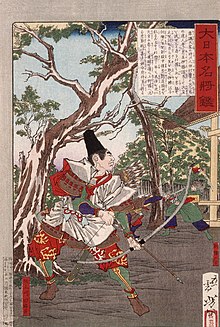
Back Rebelión de Fujiwara no Nakamaro Spanish شورش فوجیوارا نو ناکامارو FA Rébellion de Fujiwara no Nakamaro French 藤原仲麻呂の乱 Japanese Мятеж Фудзивара-но Накамаро Russian Biến loạn Fujiwara no Nakamaro VI 藤原仲麻吕之乱 Chinese
| Fujiwara no Nakamaro Rebellion | |||||||
|---|---|---|---|---|---|---|---|
| |||||||
| Belligerents | |||||||
| Fujiwara no Nakamaro | retired Empress Kōken | ||||||
| Commanders and leaders | |||||||
| Higami no Shioyaki(Prince Shioyaki) | Fujiwara no Kurajimaro | ||||||
| Casualties and losses | |||||||
| Fujiwara no Nakamaro and Higami no Shioyaki were killed | |||||||

The Fujiwara no Nakamaro Rebellion (藤原仲麻呂の乱, fujiwara no nakamaro no ran), also known as the Emi Rebellion,[1] was a short-lived and unsuccessful Nara period military confrontation in Japan resulting from a power struggle between former Empress Kōken and the main political figure of the time, Fujiwara no Nakamaro from the powerful Fujiwara clan.
Through the support of Emperor Shōmu and Empress Kōmyō, with whom he had family-ties, Nakamaro rapidly climbed the career ladder during the 740s and 750s achieving some of the highest ranks and court positions. During the early years of the reign of Emperor Junnin, whom he supported, Nakamaro ruled the country de facto. Following the death of Kōmyō in 760, the retired Empress Kōken started to take government affairs into her hand resulting in a conflict between Nakamaro/Junnin on one side and Kōken and her close associate Dōkyō on the other.
In order to restore authority, on the 11th day of the 9th month, Tenpyō-hōji 8 (October 14, 764), Nakamaro seized the signs of imperial authority and left the capital at Nara for the Eastern Provinces. The group around Kōken reacted by mobilizing an army and blocking access on the main roads. The two armies eventually engaged in a battle a week later on the 18th day of the 9th month (October 21, 764) at Miozaki on the western side of Lake Biwa in which Nakamaro was killed, ending the rebellion.
- ^ "The Million Pagoda Charms, British Library, retrieved May 30, 2019". Archived from the original on December 23, 2019. Retrieved May 30, 2019.